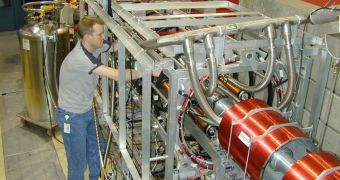A decade-long investigation of the matter-antimatter imbalance that allowed everything in the Universe to form has finally concluded at the US National Institutes of Standards and Technology (NIST). The team says that this was the most precise study of its kind ever conducted.
What experts analyzed was why matter won the battle with antimatter shortly after the Big Bang. The current cosmological model astronomers agree upon explains a lot of things, except our very existence.
In fact, under the Big Bang model, there shouldn't be any stars, black holes, galaxies, cosmic dust or gas, or anything else altogether. As equal amounts of matter and antimatter were created in the earliest possible moments of the Cosmos, the two should have canceled each other out.
As it's plainly obvious, this did not happen. Matter somehow managed not to get entirely annihilated by antimatter, and how and why this happened has been a mystery to scientists ever since the imbalance was first identified, SpaceRef reports.
NIST investigators set out to discover the answer by analyzing the radioactivity of atomic nuclei components called neutrons. They explain that the early clash between the two forms of matter annihilated most of both, but left behind some baryonic matter.
“The question is, why was there an excess of one over the other in the first place? There are lots of theories attempting to explain the imbalance, but there’s no experimental evidence to show that any of them can account for it,” Pieter Mumm explains.
“It’s a huge mystery on the level of asking why the universe is here. Accepted physics can’t explain it,” adds the investigator, who holds an appointment as a physicist at the Physical Measurements Lab.
He says that the NIST team sought to determine whether neutron radioactivity led to the particles decaying in different manners for matter and antimatter. If that were the case, then it would imply that nature favors baryonic matter over the other type, therefore explaining the imbalance.
A highly-advanced detector based at the NIST Center for Neutron Research (CNR) was used to conduct the most precise measurements of neutrons ever conducted. The 10-year study has thus far revealed no significant imbalance between the two radioactive decay paths.
However, even in defeat, the NIST team collected valuable data. The new conclusions will now be used to severely limit the number of theories potentially explaining the imbalance. As the CNR detector is improved, it may be possible to refine these numbers even further.
“We have placed very tight constraints on what these theories can say. We have given theory something to work with. And if we can modify our detector successfully, we can envision limiting large classes of theories. It will help ensure the physics community avoids traveling down blind alleys,” Mumm says.
The study included experts from the University of Washington, the University of Michigan, the University of California in Berkeley, Lawrence Berkeley National Laboratory, Tulane University, the University of Notre Dame, Hamilton College and the University of North Carolina in Chapel Hill.

 14 DAY TRIAL //
14 DAY TRIAL //